While the conventional wisdom holds that it is never possible to "time the market," it might seem that major shifts – like the quadrupling of the US stock market over the last decade – should be at least partly foreseeable. Why aren't they?
NEW HAVEN – Should we have known in March 2009 that the United States’ S&P 500 stock index would quadruple in value in the next ten years, or that Japan’s Nikkei 225 would triple, followed closely by Hong Kong’s Hang Seng index? The conventional wisdom is that it is never possible to “time the market.” But moves as big as these, it might seem, must have been at least partly foreseeable.
The problem is that no one can prove why a boom happened, even after the fact, let alone show how it could have been predicted. The US boom since 2009 is a case in point.
In looking at the US stock market, it is important to bear in mind that its participants are overwhelmingly US investors. According to a US government study published last year, despite some growth between 2009 and 2017, the share of the US stock market owned by foreigners was still only about one-seventh in 2017. But if all people heeded financial advisers’ counsel and were completely diversified, people outside the US, who held more than two-thirds of the world’s wealth as of last year, would own over two-thirds of the US stock market as well. Home-country bias, or patriotism, is a big factor in the stock market. So, to understand the US stock market’s strength, we need to consider the thinking of its participants.

NEW HAVEN – Should we have known in March 2009 that the United States’ S&P 500 stock index would quadruple in value in the next ten years, or that Japan’s Nikkei 225 would triple, followed closely by Hong Kong’s Hang Seng index? The conventional wisdom is that it is never possible to “time the market.” But moves as big as these, it might seem, must have been at least partly foreseeable.
The problem is that no one can prove why a boom happened, even after the fact, let alone show how it could have been predicted. The US boom since 2009 is a case in point.
In looking at the US stock market, it is important to bear in mind that its participants are overwhelmingly US investors. According to a US government study published last year, despite some growth between 2009 and 2017, the share of the US stock market owned by foreigners was still only about one-seventh in 2017. But if all people heeded financial advisers’ counsel and were completely diversified, people outside the US, who held more than two-thirds of the world’s wealth as of last year, would own over two-thirds of the US stock market as well. Home-country bias, or patriotism, is a big factor in the stock market. So, to understand the US stock market’s strength, we need to consider the thinking of its participants.